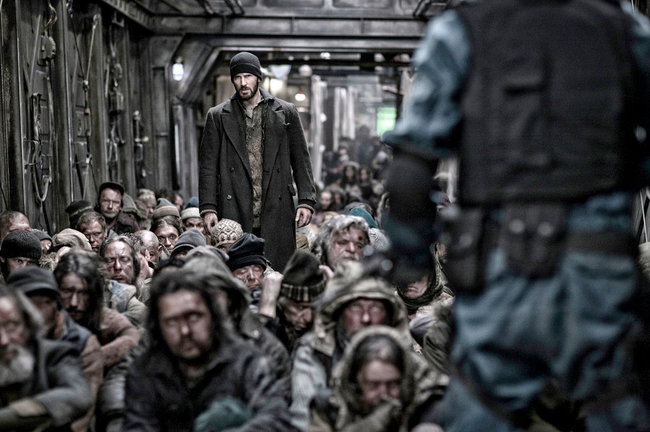Review: Snowpiercer
Directed by Bong Joon Ho • 2013 • 126 min
Having largely taken over for the Western, Science Fiction offers new, futuristic frontiers, reframing reality to provide us with a twisted mirror image of the present day. In Snowpiercer, Korean director Bong Joon Ho propels income inequality into a dystopic future, where climate change has frozen the Earth. The last of humanity is forced to live on a train, perpetually moving around the globe. At the front of the train are the upper classes, living in the lap of luxury, while at the tail end the poor struggle for survival. The social order is threatened when Curtis (Chris Evans) leads a group of would-be revolutionaries forward one car at a time. They will take control of the train’s front engine or die trying.
Snowpiercer is visually stunning. A rich, almost overwhelming spectrum of shades and colours is slowly unveiled as our heroes advance, from the bleak greys and browns of the train’s rear section to the flamboyance and excess of the front. All of this is set within the icy cold landscape of the snow-covered globe. The extreme contrasts – of light and dark, blood and snow, filth and luxury – blend superbly with the transitions from the train’s interior sets and CGI exterior.
The film’s plot may sometimes seem blunt and awkward. Obvious symbols force us to the conclusion that the distribution of wealth is unjust and built on greed and corruption. But this is perhaps Snowpiercer‘s greatest strength. Joon Ho abandons subtlety at the outset in favour of stylish hyperbole. Everything stands for something else. In one particularly elegant, evocative moment, a group of the train’s footsoldiers, looking like a cross between an S&M orgy and bloodthirsty hangmen, inexplicably take turns gutting a fish. A display of power for Curtis and his crew. The upper class will waste resources to prove a point, and that point is that the poor are nothing more than an unpleasant chore, fish to be gutted.
The straightforward symbolism of the film is perhaps most pronounced in the architectural layout of the train, with each car representing one distinct facet of society. There is the working class food production car, the superfluous high-end sushi car, the education/propaganda car, the spa car, the nightclub car, and so on. None of these seem to be particularly well designed or arranged in a practical way. Seeing our heroes forced to walk through a sauna car to move ahead highlights just how ludicrous the train’s design truly is. The train is an idea, a metaphor for social hierarchy, with each compartment one step ahead, literally and figuratively, of the last. What we are left with is a very clear condemnation of the ruling class: rich, lazy people who spare nothing for the poor and oppressed, kept against their will in the cramped ghettos of the rear. Not coincidentally, the train’s sole function is to maintain its own momentum and to move in circles indefinitely.
American mythologies tend to benefit from outside perspectives. The Spaghetti Westerns of the 60s provided a gritty, nihilistic take on the rugged individualism of John Wayne. Perhaps even more than this, Snowpiercer brings to mind Luc Besson’s The Fifth Element, where a typically stoic Bruce Willis seems utterly out of place in the queer future of French comic books, requiring a damsel in distress for any kind of personal fulfilment. With an international cast and a setting that spans the entire globe, Snowpiercer remains distinctly American. Curtis (played by Captain America himself) takes on a leadership role at the outset. We’re never told exactly why, but the Hollywood logic of it all makes perfect sense. He’s the handsome, able-bodied white male in a diverse group of marginalised people. On his quest for justice, he butts heads with various strong characters: a woman of colour, determined to get her abducted son back from the front of the train; a Korean security expert and his skilled daughter; a mute orphan with advanced fighting abilities. Any of these characters could take command, yet Curtis is the one and only character born to lead, we’re told. Like Willis in The Fifth Element, he is rugged, manly, and his goals are both simple and noble. He is a conservative vestige of bygone days, a positive alternative to the train’s hypercapitalism, but certainly not a symbol of true progress. Where does his authority come from? Like the engineer at the top of the food chain, played by a stern, fatherly Ed Harris, Curtis is a self-appointed leader, and the film doesn’t let him off the hook for this. Progress requires something other than these men, something new and revolutionary.
Revolution isn’t quite as romantic as Hollywood might have us believe. It isn’t clean or simple either. Instead, it requires a genuine reappraisal. Snowpiercer asks us to take stock, to ask who is in charge, why, and what might be done about it without offering any easy answers.
